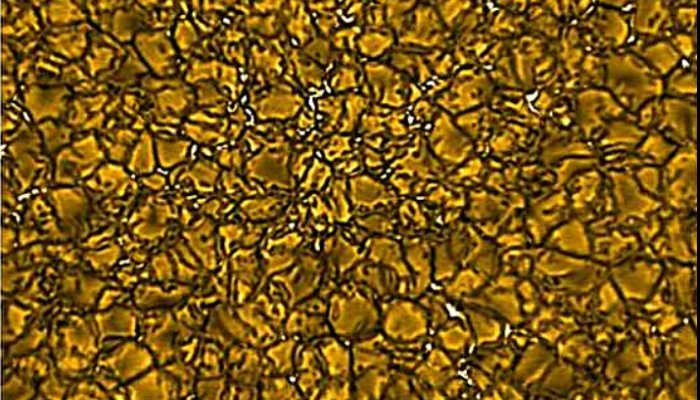Eddie Gonzales Jr. – MessageToEagle.com – Astronomers have been trying to solve the mystery of the Sun’s corona for a long time. The corona is in the outer layer of the Sun’s atmosphere—far from its surface. Yet the corona is hundreds of times hotter than the Sun’s surface.
Now, astronomers are one step closer to understanding one of the most enduring solar mysteries, having captured unprecedented data from the sun’s magnetic field.
Small-scale magnetic structures of the ‘quiet Sun’ at high resolution captured by DKIST. Credit: Queen’s University Belfast
The groundbreaking data collected from the US National Science Foundation’s (NSF) Daniel K Inouye Solar Telescope (DKIST) in Hawaii—the most powerful solar telescope in the world—has provided the most detailed representations to date of the magnetic field of the so-called ‘quiet’ surface of the sun.
An international team of scientists, including researchers from the University of Sheffield, believe the data has implications for how we model energy transfer between the layers of the sun. The research has been published in Astrophysical Journal Letters.
This might help explain one of the biggest conundrums in astrophysics—why the outermost layer of the sun (‘corona’) is hundreds of times hotter than the surface (‘photosphere’), even though the opposite would be expected.
Professor Robertus Erdelyi, a senior co-investigator from the University of Sheffield’s School of Mathematics and Statistics, said, “The observations have revealed and confirmed a serpentine topology of the magnetic field in the lower solar atmosphere, often also called the chromosphere. An accurate insight into the magnetic field geometry is fundamental for the understanding of the various energetic phenomena that drive the dynamics of the plasma in the solar atmosphere.
Image of corona from NASA’s Solar Dynamics Observatory showing features created by magnetic fields. Image credit: NASA
“That includes the much sought after magnetic behavior that may ultimately be responsible for energizing the solar plasma to temperatures of millions of Kelvins. These magnetic fields are also believed to drive the largest and most powerful explosions in our entire solar system, the Coronal Mass Ejections (CMEs). ”
Inaugurated in 2022, DKIST is the most powerful, solar, optical telescope on Earth. It enables record-breaking observations of the sun, with a resolving power being the equivalent to seeing a 50p coin in Manchester from London.
The project led by Queen’s University Belfast in collaboration with the University of Sheffield, the NSF’s National Solar Observatory, the High Altitude Observatory at California State University, the Max Planck Institute for solar system Research in Germany and Eo¨tvo¨s Lora´nd University in Hungary, harnessed this power to reveal a new, complex, snake-like pattern of energy in the magnetic field.
In the past, much research into the heat variations between the corona and photosphere has focused on ‘sunspots’—very large, highly magnetic and active regions, often comparable to Earth in size—that can act as conduits for energy between the sun’s outer layers.
Away from sunspots, the so-called ‘quiet sun’ is covered in convective cells known as ‘granules,’ typically about the size of France, that harbor much weaker, but more dynamic magnetic fields that may hold the secrets to balancing the energy budget of the chromosphere.
Most observational reports of the past decade have found that magnetic fields are organized in terms of small loops in the quiet photosphere. With DKIST, researchers have detected something unexpected, finding the first evidence for a more complicated pattern consistent with a snake-like variation in the magnetic orientation.
Professor Michail Mathioudakis, Co-Investigator on the research and Director of ARC at Queen’s said, “The more complex the small-scale variations in magnetic-field direction, the more plausible it is that energy is being released through a process we call magnetic reconnection—when two magnetic fields pointing in opposite directions interact and release energy that contributes to atmospheric heating.
“We have used the most powerful solar optical telescope in the world to reveal the most complex magnetic-field orientations ever seen at the smallest scales. This brings us closer to understanding one of the biggest conundrums in solar research.”
Professor Erdelyi added, “Thanks to this research we may be one step closer in comprehending the sun, our life-giving star.
“These are fantastic results achieved by a combination of junior and senior scientists across a wide range of institutions at both sides of the Atlantic ocean. The DKIST solar telescope, the largest of its kind, has opened revolutionary new avenues in solar physics.”
Original story – University of Sheffield
Written by Eddie Gonzales Jr. – MessageToEagle.com Staff Writer








